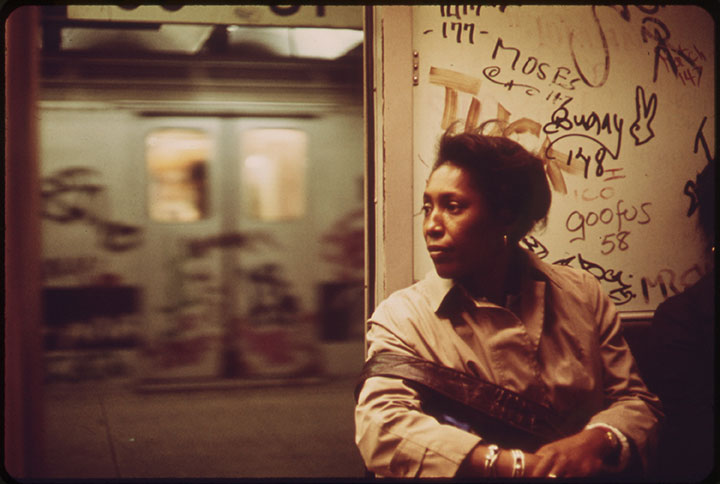OCTOBER 2018 Exhibit:
DOCUMERICA Photography Series
From 1972 through 1977 the Environmental Protection Agency (EPA) hired photographers and writers to document the degradation of our shared environments. Over 80,000 photographs were produced and now 15,000 have been made publicly available in the National Archives.
For weeks we’ve spent time sorting through the archives to find images that we feel capture not only the vast extent of pollution at that time, but the bold, creative ways that Americans were able to innovate and repair their land.

Caption: A city farmer tends to his vegetables in the Fenway Gardens administered by the Fenway Civic Association. An outgrowth of the victory gardens of WWII, the association has 600 members who cultuvate a total of 425 garden plots in these five acres of metropolitan Boston.
Photographer: Ernst Halberstadt
Date Created: 1973 August
When the EPA was first created it was not considered a political project. Unchecked land development, urban decay, and persistent air, water, and noise pollution were all so incredibly apparent that there was strong bipartisan support for the creation of the agency.
The DOCUMERICA photography series was one of the very first EPA projects. It began in the early 1970’s to document the state of the environment at the time and the way that citizens interacted with their local environments, for better or worse.
More than 100 professional photographers were paid $150 a day, given as much film as they could use, and sent around the country to document specific instances of pollution as well as the overall effects of unregulated industrialization on actual people.
This unique approach went beyond simply documenting problems— it attempted to take a holistic view of the complicated relationships between the people and their land. This allowed photographers to examine where and how we live, and the role of urban planning and public spaces because, as was the project’s motto, “everything is connected to everything else.”
Caption: Abandoned automobiles and other debris clutter an acid water-and-oil-filled five acre pond. It was cleaned up under EPA supervision to prevent contamination of Great Salt Lake and a wildlife refuge nearby.
Photographer: Bruce McAllister
Date Created: 1974 June
Caption: Children play in yard of Ruston home, while Tacoma smelter stack showers area with arsenic and lead residue.
Photographer: Gene Daniels
Date Created: 1972 August
Caption: One of several highrise apartments whose construction was stopped by city ordinance to preserve the Breezy Point peninsula for public recreational use.
Photographer: Arthur Tress
Date Created: 1973 May
Caption: Earth, as seen by astronauts Eugene Cernan, Ronald Evans and Harrison Schmitt from Apollo 17.
Photographer: NASA
Date Created: 1972 December
Caption: Mary Workman holds a jar of undrinkable water that comes from her well and has filed a damage suit against the Hanna Coal Company. She now has to transport water from a well many miles away.
Photographer: Erik Calonius
Date Created: 1973 October
Caption: The Atlas Chemical Company belches smoke across pasture land in foreground. It is referred to disparagingly in the community because black soot from the plant covers everything nearby.
Photographer: Marc St. Gil
Date Created: 1973 May
Caption: In 1972 a pipeline burst releasing 285,000 gallons of crude oil into the San Juan River. Flooding then caused the river to overflow into Lake Powell. The jars shown here contain water samples taken by EPA workers at the site for lab analysis.
Photographer: David Hiser
Date Created: 1972 October
Caption: Children in Fort Smith, Arkansas are learning that protecting the environment will take more than awareness.
Photographer: Jim Olive
Date Created: 1972 June
Caption: Closeup of an old coal company mining town of Red Ash Virginia. This is a classic picture of a company town with a railroad in the valley flanked by miners homes. These houses are two family dwellings; the road is made of red dog, a mining byproduct.
Photographer: Jack Corn
Date Created: 1974 April
Caption: Exhibit at the first symposium on low pollution power systems development. Vehicles and hardware were assembled at the EPA Ann Arbor Laboratory. Photo shows participants looking over the ESB "Sundancers", an experimental electric car.
Photographer: Frank Lodge
Date Created: 1973 October
Caption: Barge loaded with ashes from the Gravesend Bay incineration plant. Ashes will be taken to ocean for dumping.
Photographer: Arthur Tress
Date Created: 1973 May
Caption: Empty steel beer and soft drink cans are being used to build experimental housing near Taos, New Mexico. Some 70,000 cans are needed to build a house which can be built as much as 20% cheaper than conventional homes.
Photographer: David Hiser
Date Created: 1974 June
Caption: There is some local opposition to stripping the land in southeastern Ohio. Most people, however, are employed by the coal companies and are afraid any demands for reform will cost them their jobs.
Photographer: Erik Calonius
Date Created: 1973 October
Caption: One of a series of portraits of miners waiting to go to work on the 4 P.M. to midnight shift at the Virginia-Pocahontas coal company mine.
Photographer: Jack Corn
Date Created: 1974 April


















